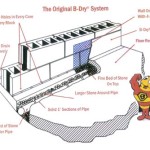How to Seal a Concrete Basement Floor
Sealing a concrete basement floor is a crucial step in maintaining a dry, comfortable, and structurally sound home. Concrete, while durable, is a porous material, allowing moisture to seep through from the ground. This moisture can lead to a variety of problems, including mold growth, musty odors, damage to stored items, and even structural damage to the foundation. Effectively sealing the concrete floor prevents water intrusion and its associated issues, creating a more habitable and healthier living space. This article outlines the steps involved in successfully sealing a concrete basement floor, focusing on preparation, materials, and application techniques.
Understanding the Importance of Basement Floor Sealing
The soil surrounding a home's foundation often contains significant moisture content. This moisture exerts hydrostatic pressure against the concrete walls and floor of the basement. Due to the porous nature of concrete, water can be drawn upwards through capillary action, a process known as rising damp. This process allows water to penetrate the concrete and enter the basement, leading to elevated humidity levels. High humidity creates a favorable environment for mold and mildew growth, which can trigger allergies and respiratory problems. Furthermore, excess moisture can damage carpets, furniture, and stored belongings. In colder climates, the water within the concrete can freeze and thaw, causing cracks and spalling (surface flaking) over time, weakening the structural integrity of the foundation.
Sealing the concrete basement floor acts as a barrier against this moisture intrusion. By applying a waterproof or water-resistant sealant, the pores in the concrete are filled, preventing water from wicking through. This keeps the basement drier, reduces humidity, and minimizes the risk of mold growth and water damage. Moreover, a sealed floor can improve the energy efficiency of the home by reducing heat loss through the concrete slab. This is especially beneficial if the basement is finished or used as a living space.
Beyond preventing moisture, certain sealants can also protect the concrete from chemical spills, stains, and abrasion. This is particularly useful in basements used as workshops or storage areas. Choosing the right sealant and applying it correctly is essential for achieving long-lasting protection and a healthier basement environment.
Essential Steps for Preparing a Concrete Basement Floor for Sealing
Proper preparation is paramount for a successful concrete floor sealing project. Without adequate preparation, the sealant may not adhere correctly, leading to premature failure and ineffective moisture protection. The preparation process involves cleaning, repairing, and profiling the concrete surface to ensure optimal sealant bonding.
The first step is to thoroughly clean the concrete floor. This involves removing all debris, dust, dirt, grease, and any existing coatings or sealants. Begin by sweeping or vacuuming the floor to remove loose particles. For stubborn dirt and grime, use a scrub brush and a solution of warm water and a mild detergent. Heavy grease or oil stains may require a degreasing agent specifically designed for concrete. Allow the floor to dry completely before proceeding to the next step. It is crucial to ensure the floor is completely dry, as any remaining moisture can interfere with the sealant's adhesion.
Next, inspect the concrete floor for any cracks, holes, or other imperfections. These flaws must be repaired before sealing to prevent water from entering through them. Small cracks (less than 1/4 inch wide) can be filled with a concrete crack filler or a patching compound designed for concrete. Larger cracks or holes may require a more substantial repair using a concrete patching mix. Follow the manufacturer's instructions for mixing and applying the patching material. Allow the patching material to cure completely before proceeding. This curing period is critical for the patch to achieve its full strength and bonding capacity.
After cleaning and repairing the concrete, it is necessary to profile the surface to create a better bonding surface for the sealant. This can be achieved through mechanical abrasion, such as grinding or acid etching. Grinding involves using a concrete grinder with a diamond grinding wheel to remove the top layer of the concrete and create a slightly rough surface. Acid etching involves applying a diluted solution of muriatic acid to the concrete, which opens the pores and improves adhesion. If using acid etching, follow safety precautions carefully, including wearing protective clothing, gloves, and eye protection. Neutralize the acid with a solution of baking soda and water after etching, and rinse the floor thoroughly with clean water. Allow the floor to dry completely before applying the sealant.
Selecting the Appropriate Sealant for a Concrete Basement Floor
Choosing the right sealant is critical for the long-term effectiveness of a concrete basement floor sealing project. Several types of sealants are available, each with its own properties and suitability for different applications. Factors to consider when selecting a sealant include the level of moisture protection required, the intended use of the basement, and the desired finish. Common types of sealants for concrete basement floors include penetrating sealants, epoxy coatings, and acrylic coatings.
Penetrating sealants, such as silane or siloxane based products, work by penetrating the concrete and reacting with the cement particles to create a hydrophobic barrier within the concrete. These sealants do not form a surface film and are virtually invisible after application. They are effective at preventing water intrusion without altering the appearance of the concrete floor. Penetrating sealants are a good choice for basements where a natural concrete look is desired or where a subsequent flooring material will be installed. They are generally easy to apply and require minimal surface preparation.
Epoxy coatings are two-part systems that consist of a resin and a hardener. When mixed together, these components react to form a durable, waterproof, and chemical-resistant coating. Epoxy coatings provide a high level of protection against moisture, stains, and abrasion. They are available in a variety of colors and finishes, allowing for customization of the floor's appearance. Epoxy coatings are a good choice for basements used as workshops, garages, or other areas where a durable and easy-to-clean surface is needed. Application of epoxy coatings requires careful mixing and application techniques to ensure proper adhesion and curing.
Acrylic coatings are water-based or solvent-based sealants that form a protective film on the surface of the concrete. They are relatively easy to apply and are available in a variety of colors and finishes. Acrylic coatings provide moderate protection against moisture and stains. They are a good choice for basements where a decorative finish is desired and where heavy-duty protection is not required. Acrylic coatings may require periodic reapplication to maintain their protective properties.
When selecting a sealant, it is essential to read the manufacturer's instructions carefully and choose a product that is specifically designed for concrete basement floors. Consider the specific needs of the basement and choose a sealant that provides the appropriate level of protection and performance.
Proper Application Techniques for Sealing a Concrete Basement Floor
The success of a concrete basement floor sealing project depends not only on proper preparation and sealant selection but also on the application technique employed. Applying the sealant correctly ensures that it adheres properly to the concrete surface, forms a continuous barrier against moisture, and provides long-lasting protection. Factors to consider during application include the ambient temperature, humidity levels, and the manufacturer's recommendations for application rates and methods.
Before starting the application, ensure that the concrete floor is clean, dry, and properly prepared. Refer to the manufacturer's instructions for the specific sealant being used. Most sealants require a specific ambient temperature range for optimal application and curing. Avoid applying sealant in extremely hot or cold weather, as this can affect its drying time and adhesion. Humidity levels can also affect the sealant's performance. High humidity can slow down the drying process and potentially compromise the sealant's bond.
Apply the sealant using a brush, roller, or sprayer, depending on the type of sealant and the manufacturer's recommendations. For penetrating sealants, a low-pressure sprayer or a roller is often used to apply the sealant evenly over the concrete surface. For epoxy and acrylic coatings, a brush or roller is typically used to apply the sealant in thin, even coats. Avoid applying the sealant too thickly, as this can lead to uneven drying and potential cracking. Follow the manufacturer's recommended application rate to ensure that the sealant provides adequate coverage. Work in small sections to ensure that the sealant is applied evenly and thoroughly.
Depending on the type of sealant, multiple coats may be required to achieve the desired level of protection. Allow each coat to dry completely before applying the next coat. The drying time will vary depending on the type of sealant, the ambient temperature, and the humidity level. Follow the manufacturer's instructions for the recommended drying time between coats. After applying the final coat, allow the sealant to cure completely before using the basement. The curing time can range from a few days to several weeks, depending on the type of sealant. Avoid walking on the floor or placing heavy objects on it during the curing process. Proper application techniques are critical for ensuring that the sealant provides effective and long-lasting protection against moisture intrusion.

Basement Floor Sealer The Best To Use For Floors

How To Prepare Concrete For Sealers And Coatings V Seal Commercial Residential Blog

Colored Concrete Sealer How To Guide

Sealing Basement Floors Why It Is Important To Seal Your

What To Know About Waterproofing A Concrete Basement Floor

Alternative Finishes For Interior Concrete Floors Decor

How To Stain Concrete Basement Floor Diy Guide

Chicago Garage Basement Commercial And Flooring By Broadleaf Sealed Concrete

A Guide To Stained Concrete Basement Floors

How To Seal A Concrete Garage Floor With Pva Part 1 Youtube
Related Posts







